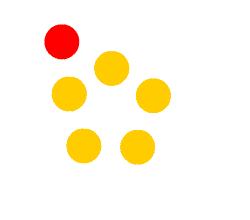Aeroplane Chess(飞行棋) is a Chinese cross-and-circle board game. It is similar to the western game of Ludo and the Indian game of Pachisi. Developed in the 20th century, Aeroplane Chess features airplanes as pieces instead of the more abstract pawns and beehive-shaped pieces found in the games from which it is derived.
An aeroplane chess game board features 4 starting “hangars” in each corner. There is a “track” of 52 spaces circumventing the board and 4 “home zones”, each leading from the track to the “end spaces” at the centre of the board. The board is evenly divides between 4 colours. There are also 4 sets of 4 coloured airplane pieces. The colours used are typically red, yellow, blue and green.
There are usually 2 to 4 players. The objective of the game is to try be the first to get all your own plane pieces from the hangars into the base of your own colour(located in the centre of the board). This games requires the players to identify the optimal moves. Each player takes a turn by rolling the die.
On a turn, a player may do the following:
-Taxi a piece out of the hangar onto the board. This can only be done by rolling an even number.
-Move a piece that's on the board clockwise around the track, the number of spaces indicated by the die.
Additional rules:
A roll of 6, whether it's used to enter or move a piece, gives that player another roll. A second 6 gives the player a third roll. If the player rolls a third 6, the piece(s) moved by the two previous 6s are sent back to the hangar.
If a player's piece lands on a space that already has one of his own airplanes, those pieces can be stacked together. Depending on house rules determined by all the players, airplanes that are stacked then move together as one unit or only move singly. When stacked pieces are sent back to their hangar by an opponent landing on them, they are no longer stacked. When a player's piece lands on a space with an opponent's airplane, the opponent's airplane is attacked and sent back to their hangar. When a player's piece lands on an opponent's stack of airplanes, then all those stacked airplanes are sent back to the hanger. When a plane lands on a space of its own colour, it immediately jumps to the next space of its own colour.
There are additional "shortcut" squares. When a plane lands on one of these of its own colour, it may take the shortcut. Any opposing planes in the path of the shortcut are sent back to their hangars. This may also be done in succession with the previous rule, with a jump leading to shortcut. Some also play that a direct land on a shortcut may be followed by a jump.
To end the game, the planes must fly into the centre base on an exact roll. When a plane does so, it is placed back into its hangar, facing down, to indicate that it is done for the game. The first player to get all four of their planes to the centre of the board wins. The remaining players play until there is only one loser.
Readers, have you all played Aeroplane Chess before? I remember always playing it with my friends back in primary school days! It was always available in the bookshop for $1.50 only, and the packaging is small and compact ^^
Want to know more about the Aeroplane Chess? Click on the Wikipedia logo below to read more about it ;)

Have a question? Type it into the box and have it answered! ^^
That's all for today!
I hope you have a great day ahead ^^
Rachel











 <-- Snap
<-- Snap











